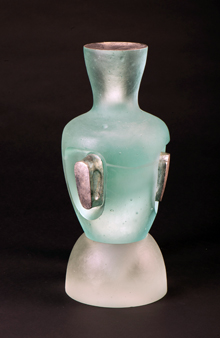
EARNEST AND ENDEARING de Strelecki’s The Pomfret Dancers In Newport. |
Women were at the center of the founding of the Newport Art Museum. They accounted for more than half of its 142 charter members when the joint opened in 1912. One woman in particular, Maud Howe Elliott, the ringleader of the seven Newport founders, was a suffragette, a Pulitzer Prize-winning author, and daughter of Julia Ward Howe, the abolitionist and author of "The Battle Hymn of the Republic," and Dr. Samuel Gridley Howe, the first director of the Perkins School for the Blind in Boston.
As the museum wraps up a centennial year of historical retrospectives, with Elliott on my mind, two artists stand out in the museum's current spotty exhibit "Image and Innovation: 100 Years of Photography from the Permanent Collection" (76 Bellevue Avenue, through January 13).
Jean de Strelecki photographed "nymph" dancers cavorting Isadora Duncan-style in Grecian dresses around Newport cliffs in 1916. The earnest and endearing portraits of the Pomfret Dancers, made to publicize the young society women's performance at the museum, reveal the neoclassical dreaming of the era.
Judy Gelles's 1979 conceptual self-portrait is a pointed feminist joke. The photo's hand-written caption explains that three afternoons each week, when her young sons are otherwise occupied, she gets an hour and a half "of free time to be creative and do important things." The punchline: Gelle photographs herself lying on the floor watching TV.
Let both the liberated playfulness at the founding and the biting satire six decades on be the institution's touchstones. At 100, the Newport Art Museum is a fusty place, clubby and polite. The museum's strength is how it embraces its community — from the current small survey of the NAM's Photographers' Guild to the upcoming NetWorks roundup of talent from across the state. But it could use more of the moxie of its founding mothers.

CLASSIC STYLE Ben Tré’s The Full Cup. |
Among the other exhibits on view is "Recasting the Loving Cup: From Traditional Silver to Contemporary Media" (through January 13). Local arts patron extraordinaire Joseph Chazan commissioned 10 local artists "to create contemporary three-handled loving cups, deriving from the Gilded Age vessel form often presented as an award or trophy and fabricated in silver."Howard Ben Tré fashions a classically-styled amphora in his signature turquoise cast glass. Jonathan Bonner presents a sort egg made of two lip-to-lip cups constructed from nylon, Delrin, and PVL. "I landed on this idea of two breasts," he says in a video in the gallery. "Which is the original loving cup. They don't need handles."
The show feels like a parlor game. And I don't quite see the fascination with loving cups. But the fab neoclassicism of Steven Easton's purple lead crystal cup, with three handles shaped like little columns, seems to be the mix of gravitas and camp that the assignment calls for.
Cuban-born, Charlestown-based artist Ana Flores says the carved wooden folksy (and somewhat schmaltzy) figures in the her exhibit "The Island Draws Me" (through January 6) are an effort to "fill this void" created when her family's heirlooms were "all swept away by the Cuban revolution." A black, wooden figure crouching under a fancy table set for coffee is a too blunt symbol of oppression. Flores is better when her touch is lighter. The Last Mambo is a cute little dancing wooden couple spinning atop a phonograph as Cuban music plays. A light projects their shadows onto the wall — like tantalizing memories of good times you wish you could recreate.